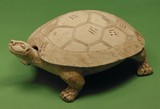
 |
Chinese (Han dynasty) Tortoise-Shaped Inkstone 206 B.C.-A.D. 220 Gray earthenware 4 inches high, 10 inches long William Hood Dunwoody Fund 32.54.4a,b |
Most Han pottery was produced from molds. It is individual hand- built pieces, like this inkstone, that show the expressiveness and wit of Han craftsmen. Here, the artist's unique interpretation combines ORGANIC and GEOMETRIC features. He has carefully hand modeled the head, face, feet, and shell to resemble a real tortoise. Before firing, and while the clay was still damp, he INCISED, or cut, patterns and symbols into the shell.
The inkstone is made of LOESS (less), an earthen material whose low clay content prevents distortion during drying and firing. Such pottery is usually left unglazed and slightly fired. The resulting EARTHENWARE is created by the REDUCTION method, which deprives the kiln of oxygen and produces a smoky atmosphere. This increases the toughness of the clay and gives it a gray tone.2 Low- fired wares such as the inkstone were produced on a large scale at both government factories and private workshops. The gray surface was generally left plain; at times it was decorated with incised lines or paint.
Notes
2. For more information about the process used, see Vainker, Chinese Pottery and Porcelain, p. 46.

Key ideas.
Where does it come from?
What does it look like?
How was it used?
How was it made?
Discussion questions.
Additional resources.
Select another piece.